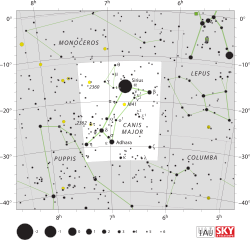Canis Major
| Constellation | |
 | |
| Abbreviation | CMa |
|---|---|
| Genitive | Canis Majoris |
| Pronunciation | /ˌkeɪnɪs ˈmeɪdʒər/, genitive /ˈkeɪnɪs məˈdʒɒrɪs/ |
| Symbolism | the greater dog |
| Right ascension | 7 |
| Declination | −20 |
| Quadrant | SQ2 |
| Area | 380 sq. deg. (43rd) |
| Main stars | 8 |
| Bayer/Flamsteed stars | 32 |
| Stars with planets | 6 |
| Stars brighter than 3.00m | 5 |
| Stars within 10.00 pc (32.62 ly) | 1 |
| Brightest star | Sirius (α CMa) (−1.46m) |
| Messier objects | 1 |
| Meteor showers | None |
| Bordering constellations | |
| Visible at latitudes between +60° and −90°. Best visible at 21:00 (9 p.m.) during the month of February. Contains VY Canis Majoris (one of the biggest stars), and Sirius (the brightest star in the night sky) | |
Sirius is 20 times brighter than the sun.

Canis Major is a constellation that is in the southern sky. It means "greater dog" in Latin (also called large dog). There is also the constellation Canis Minor, which means "lesser dog" in Latin. The astronomer named Ptolemy listed Canis Major when he made a list of 48 constellations. It is also one of the 88 modern constellations that were made by the International Astronomical Union.[1]
The star Sirius is in Canis Major. Sirius has a magnitude of -1.44, which means that it is the brightest star in the night sky. It is sometimes called the "dog star." Also, Sirius is only 8.6 light years away from Earth, which is very close (compared to other stars).[2] It also contains one of the largest stars known, VY Canis Majoris. VY Canis Majoris is around 1,500 times the size of the sun. The constellation also includes the blue bright giant star Aludra, yellow supergiant Wezen, and red giant Sigma Canis Majoris.
References
[change | change source]- ↑ Ridpath, Ian. "Chapter One Continued". Star Tales. Retrieved 31 January 2013.
- ↑ Kaler, Jim (26 September 2009). "Sirius (Alpha Canis Majoris)". Stars. Retrieved 31 January 2013.
